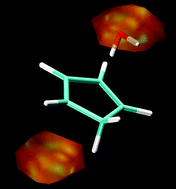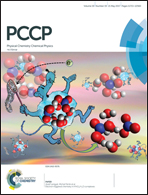Water structuring above solutes with planar hydrophobic surfaces†
Abstract
Many important biological solutes possess not only polar and hydrogen bonding functionalities, but also weakly-hydrating, or hydrophobic, surfaces. Theories of the hydration of such surfaces predict that their solvent interactions will change from a wetting type interaction to a dewetting regime as a function of the solute size, with a gradual transition in behavior taking place around characteristic lengths of ∼1 nm. Aggregations of non-polar species over this size range will undergo a transition from being dominated by entropy to being dominated by enthalpy. These transitions can be understood in part in terms of the geometries required of the solvating water molecules. We report here a series of simulations in aqueous solution of organic molecules with planar faces of increasing size, ranging from cyclopropane to circumcircumcoronene, in order to explore the transition in behavior for such solutes as their size increases. For this series, the dewetting transition occurred gradually, converging asymptotically to a limiting separation value for first layer water molecules of around 3.3 Å, while the transition in hydrogen bonding orientational structure occurred between cyclopropane and cyclopentadene. Water immediately adjacent to the largest planar hydrophobic surfaces oriented in ways that resembled on average the structural organization of the basal planes of ice.



 Please wait while we load your content...
Please wait while we load your content...